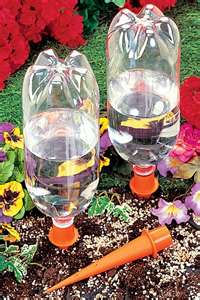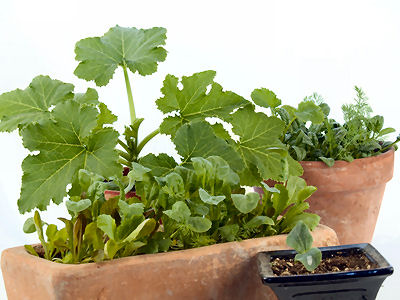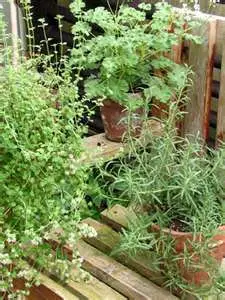Herb Gardening in Containers
Herb gardening in containers is easy - there is almost no maintenance required.
Do you add herbs and spices to your recipes? You are probably a better cook than I am - you would almost have to be - but even I can appreciate using herbs for flavor and scent. And the good news is - herbs were made to be grown in containers!

Herb gardening in containers can be successfully done in almost any type of pot or box. Just make sure there is good drainage - this absolutely necessary for growing herbs. Most varieties of herbs prefer fast draining soil, so lots of herb gardeners like terracotta because of its moisture wicking properties.
Make sure you choose the size of pot to fit your plants. If the container is too small, the plants will become root bound. It if is too large, all of the plants energies will be spent on root production and they won't grow or bloom properly.
The strong, aromatic scent of most herbs keeps pests away, but if you find you have a problem, make sure to use a safe organic pesticide.
Soil and fertilizer
A high-quality potting soil is best for herb gardening in containers. Don't use soil from your garden beds as it is too heavy. The soil will compact when watered and dry up too quickly. Use a potting mix that is loose and will drain well. You can purchase a quality potting mix or make your own. A good mix includes equal parts of potting soil, peat moss and perlite.
Herbs in general need little fertilizer, but herb gardening in containers will require some. Mix some organic fertilizer into your potting mix before planting If the color of the plants starts to fade, or they look droopy, add some water soluble fertilizer to your watering routine - use about half the recommended strength. Too much fertilizer will product large plants but the flavor and aroma of the herbs will be reduced.
Watering

Most herbs like dry conditions - check the watering requirements for each variety. Water you plants when the soil fades in color and is dry to the touch. How much water your plants will need depends on the soil mix, temperatures, size of the plants and containers.
When herb gardening in containers, never let herbs sit in water.
If checking your plants or watering daily is a challenge, consider a slow drip watering system. You can purchase them, but you can make your own at little or no cost.
Sun lovers
Herbs get their flavor and scent from essential oils that are produced in the plants best when they get plenty of sun. Successful herb gardening in containers requires at least 6 hours of sun per day. Check seed packets or plant labels to find out the lighting needs of your plant and make sure the spot where you locate your container garden will provide that.
If you decide to keep a year round garden, and your climate requires you to move your containers indoors, sitting them in a window with a southern exposure would be the best location.

Herbs should not be used to treat any medical condition without first checking with your doctor.
American Herb Society - their top 10
Sweet Basil (Ocimum
basilicum)
Basil is used in salads (tuna, green, potato or egg), used with fresh tomatoes,
eggplant, peppers, zucchini, in marinades or pesto. It works well in combination
with tomatoes and mozzarella cheese. Try basil on a sandwich of whole wheat
bread with tomatoes and mayonnaise.
Common Thyme (Thymus
vulgaris)
Thyme is used in chicken broth and
stuffing, marinades for meat or fish, lamb, veal, sauces, soups or egg dishes,
often used in partnership with tomatoes, works well in oils and butters. Lemon
thyme can be used with fish, in
tea and in salad dressings.
Bay (Laurus nobilis)
Bay leaf is added at the beginning of cooking soups and stews and imparts a
deep rich flavor. The leaf is left whole so it can be retrieved prior to
serving. Fresh leaves are stronger than dried.
Common Sage (Salvia
officinalis)
Sage is used in sausage, poultry, stuffing, pork, lamb, seafood, vegetables,
breads and is used as a spice rub for pork chops or pork tenderloin. It is also
frequently used in salads.
Greek Oregano (Origanum
vulgare)
Oregano is used in soups, casseroles, sauces, stews, stuffings, eggs, tomato-based
dishes, chili and pizza.
Chives (Alliums schoenoprasum)
Chives are used in vinegars, soft cheeses, salads, used as garnish. Its leaves work
well in butter and oils.
Dill (Anethum
graveolens)
Dill seeds are often combined with onions, cabbage, potatoes, cumin, chili
powder, paprika. Seeds can be added to casseroles, lamb, fish, vegetable dishes
and sauces. Chopped or whole dill weed can be added to soups, stews,
casseroles, meat dishes, pasta, eggs and used to enhance sauces, dips, butters
and cheeses.
Parsley (Petroselinum
crispum)
Parsley is used in soups, stews, gravies, salads, meat and potatoes, used as a
garnish and a breath freshener. Be generous with this herb in tomato dishes.
Rosemary (Rosmarinus
officinalis)
Rosemary is used with lamb, venison, poultry, soups, stews, fish, tomatoes
sauces, vegetables, marinades, and can be used as skewers for vegetables and
meats on the grill, works well in a trio with sage and thyme or garlic and
thyme, tastes great on steamed red potatoes or peas.
Lavender is used in beverages, is an ingredient in herbes de Provence blends and in a variety of sweet dishes. Lavendula angustifolia is best for culinary use and the flowers should be harvested just prior to opening and dried before use.
For other recommendations for herb gardening in containers, use the National Gardening Association as a resource. You can search for plants, including herbs, according to growing zone, light recommendations, etc. This is one of my most-used resources.
Return Home enjoycontainergardening.com
Gardening Resources
Click the link below to visit my aStore @ Amazon -
Books & How To Help
Garden Tools & Supplies
Online Plants


New! Comments
Please leave me a comment and let me know if you like what you see here and if the information is helpful. Thanks.